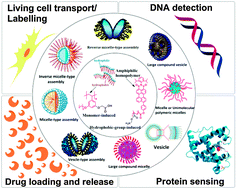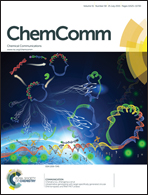Self-assemblies of amphiphilic homopolymers: synthesis, morphology studies and biomedical applications
Abstract
The need for a simplified access to supramolecular assemblies with enhanced tenability has led to the development of amphiphilic homopolymers (APHPs). This feature article highlights recent advances and future trends in APHP design, self-assembly, and biomedical applications. APHP self-assemblies are prepared by two different routes: the “monomer-induced” method, which polymerizes functional amphiphilic monomers into micelles and inverse micelles, and the “hydrophobic-group-induced” method, which uses the non-covalent interaction provided by large hydrophobic endgroups. Special emphasis is paid to unimolecular polymeric micelles (UPMs) which are formed from core–shell APHPs and which consist of a hydrophobic/hydrophilic core coated with a polymer shell. The self-assembled supramolecular structures hold promise for various biomedical fields, including living cell transport, fluorescence labelling, protein sensing and extraction, DNA detection, and drug loading and release.


 Please wait while we load your content...
Please wait while we load your content...